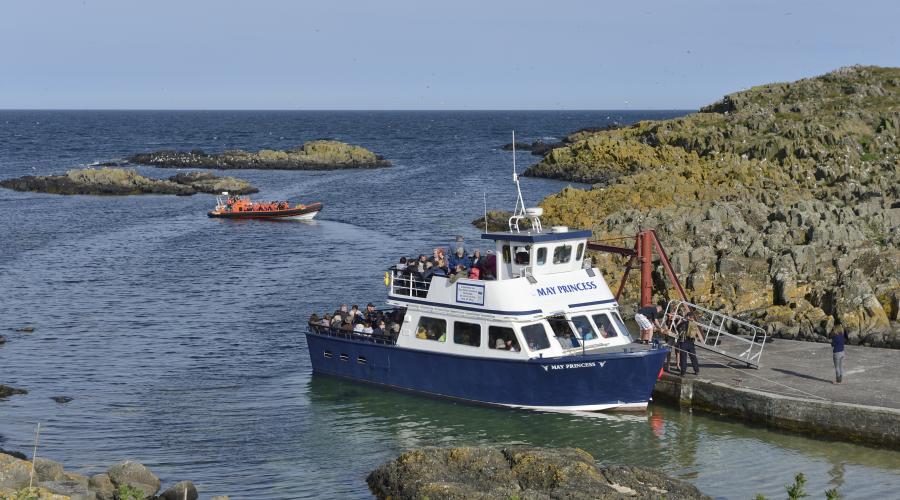
Isle of May NNR - Visiting the reserve
Visit the Isle of May NNR to experience a magical mix of seabirds, seals and smugglers.
NatureScot's Isle of May National Nature Reserve (NNR) will be opening for public landings on Monday 1st April 2024 until Monday 30 September 2024.
Avian influenza – latest news
Seabird populations including those on the Isle of May have been hit hard by Avian Influenza (Bird Flu) in recent years. This had devastating consequences and resulted in the death of many seabirds across the British Isles. The virus is still circulating widely in wild bird populations across the UK and beyond. To prevent the transmission of the virus by visitors, biosecurity measures will be in place for all visitors to the island. All footwear must be free from mud, and disinfectant footbaths will be provided to disinfect footwear on arrival and departure. We thank our visitors and all the boat operators for supporting this action and helping protect our precious seabird populations.
Getting here
You need to take a ferry to reach the Isle of May. Ferries depart from Anstruther in Fife, or Dunbar and North Berwick in East Lothian.
FROM ANSTRUTHER:
Boats depart from the harbour and tickets can be purchased from the ticket office by the Lifeboat station. There is parking nearby (200 metres) and the nearest bus stop is at East Shore (100 metres). There are 2 operators:
- Anstruther Pleasure Cruises
A round trip of up to 5 hours in the May Princess, including time to explore the island. The ferry has 100 seats – 35 covered – refreshments, a toilet and partial disabled access. For further details visit Anstruther Pleasure Cruises website.
- Osprey Rib
A round trip of 4-4.5hrs, the Osprey Rib takes 12 people and is a open fast boat journey including time to explore the island on foot. For further details visit the Isle of May Boat Trips website.
FROM DUNBAR:
- Bluewild rib
This is a 5 hour round trip in a fast boat via Bass Rock including 3 hours ashore with a Bluewild guide. For further details visit the Bluewild website.
FROM NORTH BERWICK:
- Seabird Centre Rib
This is a 4-hour round trip, including time to explore the island. Depending on when you land, you are either accompanied by a guide or are free to explore on your own. Please check with the Scottish Seabird Centre when booking (telephone 01620 890202). Travel is on a rigid inflatable boat (RIB), which is open to the elements. Waterproofs will be provided.
Map
Isle of May National Nature Reserve
For visitors
A map of the island showing the trails and key things to see will be given when you book your ferry ticket.
The visitor centre is open throughout the season.
It nestles into a slope overlooking the main harbour. An external viewing area looks out across the island. It has excellent views of wildlife, the shoreline and the south of the island. Large windows offer more sheltered viewing from inside the building.
An outdoor information area provides details on where to go and what can be seen around the island. We update this regularly with news and wildlife sightings. Interpretation boards inside provide more information about the island through the seasons, it wildlife, work and research. There are also information panels around the island, which explore the Isle of May’s history and people.
NatureScot Cupar office telephone: 01738 458800
Toilets
There is a fully accessible toilet at the visitor centre.
Anstruther harbour has an accessible toilet in the harbour car park. Please contact Fife Council for opening times and accessibility information. Telephone 01592 417823.
Rest areas
Shelter is available in the visitor centre, the South Horn and the old bath house. The visitor centre has no steps. The South Horn has a flight of steps with a handrail, and there are steps going into the bath house.
Find out more on
Related Links
- Designation and management of Scotland’s National Nature Reserves
- Learn more about other protected areas



